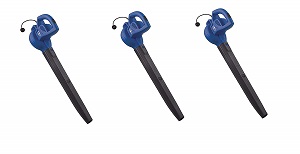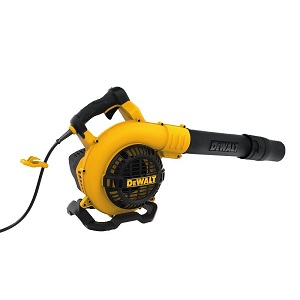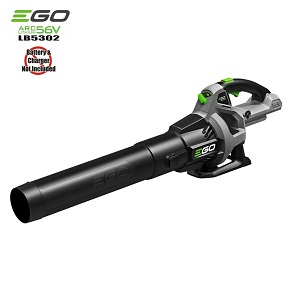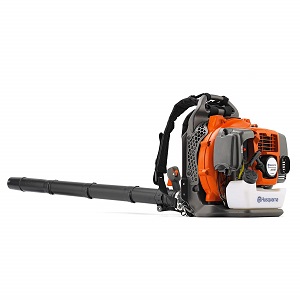Raking leaves can be a real hassle in the spring, after the snow melts, and in the fall, while they’re actively piling up in your lawn, garden or driveway. But you and your neighbors might not appreciate all the noise your average leaf blower puts out, either.
Nonetheless, if you’re tired of raking leaves and want a quick, quiet alternative to raking, we’ve found the five best quiet leaf blowers for clearing up your outdoor spaces. We’ve taken all of the guesswork out of picking the quietest leaf blowers on the market! This means your neighbors won’t be disturbed or have their conversations interrupted while you’re cleaning your yard or walkway, and you won’t hear any high-pitched whirring or ringing while you work.
Disclosure: This page contains affiliate links. As an Amazon Associate, we earn a commission from qualifying purchases.
Sun Joe SBJ597E-SJB Electric Leaf Blower
This powerful little leaf blower from Sun Joe uses 6 amps of power to deliver impressive 155-mph winds. It’s great for clearing your yard, driveway, walkway and garden of leaves and light amounts of snow. It’s quiet, non-intrusive and is easy to store away between uses.
Toro 51621 UltraPlus Leaf Blower
This electric leaf blower from Toro can keep up with some of the bigger backpack blowers in terms of power, but without all of the unpleasant noises some of the larger ones make. It comes with all the accessories you’ll need to bag and mulch leaves and other organic debris in your yard or walkway. So if you’re looking for a quiet, lightweight, multipurpose unit, this is a great leaf blower for you.
DEWALT DWBL700 Electric Blower
DEWALT is well-known for putting out high-quality equipment, and this electric blower lives up to what you’d expect from the company. It’s a corded leaf blower, so you’ll need a heavy-duty extension cord if you want to venture to the edges of your yard to blow the leaves away. It’s relatively quiet at 69 dBA, much more so than most gas-powered models, so you won’t wake up the whole neighborhood when you use it.
EGO 56-Volt Cordless Electric Turbo Blower
If you want one of the quietest cordless electric leaf blowers around, the EGO 56-Volt is a fantastic option. Along with having variable speed control settings, it also has a turbo boost function that will blast away leaves and other types of debris at 530 CFM. The battery, which has to be purchased separately, delivers up to 75 minutes of uninterrupted use after a relatively short 50-minute charge time.
Husqvarna 965877502 350BT Gas Backpack Blower
Husqvarna produces fantastic products, and this backpack leaf blower is no different. It’s gas-powered, and is by far the loudest model on this list, but it’s still quiet at a distance. It uses unique X-Torq technology to increase fuel efficiency, reduce emissions by up to 60 percent and lengthen the overall operational time.
Bottom Line
All in all, we found that electric models of leaf blowers tend to be much quieter than gas-powered models, but you still have to exercise some caution about which ones are quietest. However, if your neighbors are sensitive to noise levels coming from your property, or you’re particularly keen on not damaging your eardrums, the leaf blowers above should suit your needs!
Leaf Blower Buying Guide
Gas or Electric: Which is Better?
Gas-powered leaf blowers are usually more powerful and can handle heavier types of debris, including wet leaves and heavy layers of snow. They’re also significantly louder, though, so they’ll be more likely to annoy your neighbors or damage your ears if you aren’t properly prepared. They can also have a negative environmental impact.
Electric blowers are either battery-operated or corded, and oftentimes, they’re lighter in weight and more convenient to use since you won’t have to mix fuel. But you will have to keep the batteries charged or invest in extension cords.
For quiet operation, electric leaf blowers are almost always the quietest options available, so for that purpose, they’re better than the gas-powered alternatives.
What is CFM?
CFM is shorthand for “cubic feet per minute.” It’s used as a measurement of airflow, specifically when it comes to heating, air conditioning, ventilation and blower capacity.
CFM is used to describe the rate at which a certain volume of air can be moved within a certain period of time. In leaf blowers and fans, it tells you how much air can be moved per minute.
The higher the number, the more air, leaves and snow your blower will be able to move in a short amount of time (this time will depend on the speed setting). To move large volumes of leaves or debris, you’ll need a blower with a higher CFM output. For smaller amounts or precise, controlled jobs, you’ll want to be able to select a lower CFM output or setting.
Noise Level and Ear Protection
Chances are, if you’re looking for the quietest leaf blowers, you live in a residential area. You don’t want to disturb your neighbors or blow your own ears out while cleaning up your yard—it’s understandable! Additionally, particularly loud equipment can sometimes result in charges related to disturbing the peace, depending on where you live.
It’s important to check the decibel output of your leaf blower before purchasing it, to make sure you’re well within the range of acceptability for your location. Even with a low decibel range, you may want to invest in proper ear protection. Earplugs or muffs will work fine—just make sure they’re properly graded for use with loud equipment.
Batteries and Charge Times
Some electric leaf blowers use batteries rather than cords. This presents unique pros and cons and, depending on your needs and intended uses, a battery-powered model may be a better choice for you.
For small, quick jobs, battery-operated leaf blowers are ideal. They’re the most portable kind of electric blower and can be used anywhere on your property, but the battery won’t last forever on a single charge. Some batteries come with quick-charge features, but others don’t.
You may benefit from having two batteries charged and available for use, depending on the amount of space you’re trying to clear of leaves and other debris. Keeping one charged for use and swapping it with the other will ensure that you always have a battery ready to use for your lawn maintenance needs.
Weight and Size
The size and weight of your leaf blower are important, because you’ll have to carry and maneuver it while you work through the leaves and other debris scattered around your yard, driveway, walkways, patio, porch and/or garden.
You don’t want a leaf blower that’s too big for you to comfortably handle, or one that fits awkwardly in your hands. Additionally, you should try to avoid one that’s much too small and requires you to hold it tightly or uncomfortably in order to avoid dropping it.
Also, you don’t want a leaf blower that’s too heavy. Regardless of the size of the blower itself, it could be particularly dense. The heavier the blower, the more fatigued you’ll feel more quickly. This can be a problem if you have large spaces to clear, or if you work slowly for any unrelated reasons.
You want to look for a lightweight leaf blower that’s easy to carry and simple to maneuver. This will minimize discomfort and fatigue, and allow you to work through your outdoor spaces freely and comfortably.
Corded Models
Some electric leaf blower models use batteries, while others are corded. Corded electric blowers are more consistently powerful than their battery-operated counterparts. There’s no worry about having to charge the battery up before using these blowers, so you can get right to work whenever you want or need to.
The downside, however, is that corded leaf blowers are precisely that. They’re tethered down by needing to be plugged into a power source, and won’t operate otherwise. This means that you’ll either have to work within the area permitted by the default cord that’s attached to a particular blower, or invest in some heavy-duty, weather-resistant extension cords.
Even with that drawback, corded leaf blowers are remarkably quiet and efficient for cleaning up any space.
Featured image: Hector Alejandro






